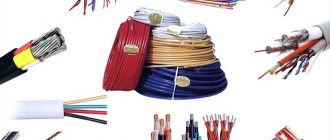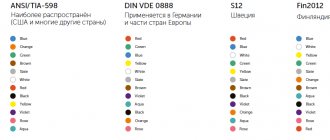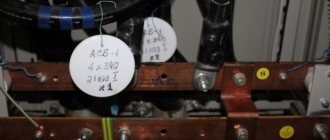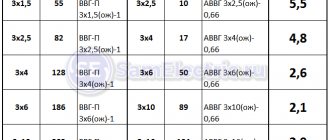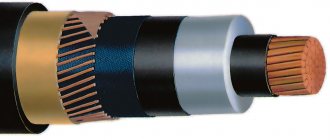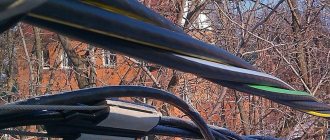Basic Concepts
A wire is understood as a single or multi-core structure, which can be bare (without insulation) or braided with rubber or plastic. Examples of the use of wires are motor windings, parts of radio equipment and power lines.
A cable is an assembly of one or more insulated cores having a single shell. To protect against damage, armor is placed on top.
Where and how to use the cable correctly
Flexible cable has a lot of modifications, which has led to its widespread use both in industry and in everyday life. Depending on the technical characteristics of a particular product, a copper stranded cable can be used in various conditions where increased elasticity of the wire is required, connecting the mechanism to the source of electric current.
When using such cables, you need to take into account its multi-core nature, which affects the connection methods in the outlet or in the distribution panel. Before installation, it is necessary to terminate the cores using special crimp-type lugs.
What is an ending
Important! In the absence of a special tool, the termination of the cores can be done by conventional soldering.
Thus, flexible copper stranded cable in PVC insulation can be of different types, which are used in various spheres of human life. Even in aggressive environments, it can last for decades. The main thing is to choose the right type and marking.
Advantages of copper conductors
It is not without reason that copper is chosen as a raw material for the manufacture of cable products. Compared to aluminum, it has a number of advantages:
- The resistance of copper wires is lower than that of aluminum. This allows the use of a smaller cross-sectional diameter and reduces heating losses.
- Good corrosion resistance. Complete replacement of supply networks is carried out after 30-35 years of operation.
- Plastic. Copper wire is very flexible, which makes the installation process easier and eliminates kinks.
Insulation layer
The manufacturing material is subject to strict requirements for withstanding voltage, temperatures, UV radiation, and mechanical properties. Most often used:It is no secret that the insulation of copper wires prevents human contact with a potentially dangerous current-carrying circuit. Another role is to prevent short circuits between adjacent phases.
- PVC. It is characterized by low cost, wear resistance, and satisfactory chemical resistance. The downside is the release of harmful gases when overheated.
- Rubber. Characterized by increased flexibility and resistance to negative temperatures.
- Polyethylene. It has excellent dielectric properties, but not as good flexibility as the first two materials.
- Carbolite. A distinctive feature is heat resistance combined with sufficient ductility.
Section calculation
The cross-section of a copper wire is the area that the core has in cross section. The value is influenced by the long-term permissible load and current strength.
The easiest way to calculate the cross-section is to use data from tables that take into account operating conditions and maximum current. To do this, you will need two more indicators - the total power of electrical consumers (kW or W) and voltage (V). The first is indicated in technical data sheets or on the housings of devices, and the second for city apartments is 220 V.
Next, the obtained power values are found in special tables and compared with the diameter of the conductor. Remember that in calculations it is necessary to leave a small margin in diameter. After all, when connecting new equipment, the load will increase.
Application of flexible cables with rubber insulation
These types of cables find their functional application in the construction of real estate - there they can be used to organize switchboards and supply electrical current to construction electrical appliances. In industry, they are used to connect machine tools, illuminate workshops, and maintain alarm systems.
Thanks to rubber insulation, such cables are used in underground communications, in open spaces without additional protection from moisture.
Wire brands
The marking of the wires contains instructions on the material design. If the designation does not contain the letter “A”, then the product is made of copper. The most popular brands are:
PBPP (PUNP) - the abbreviation stands for household, industrial flat wire. This product has a cross section of up to 6 sq. mm with PVC insulation. Operates in the range from -15 degrees to +50 degrees. Suitable for installation of lighting systems.- Buy power cable VVGngls
Electrical wiring diagram in the garage - features of design and installation with your own hands. 120 photos of wiring examples and video instructions for replacing wiring in the garage
- Which wire to use for grounding: calculation of parameters, marking and purpose of various types of wires (video instructions + 150 photos)
PBPPg (PUGNP) - unlike the previous one, contains stranded conductors. In the name, the letter “g” means flexible. The smallest bending radius is equal to six diameters. Otherwise similar to PBPP. Sold in coils of 100 m, 200 m.
PPV is a flat wire with an insulating layer of PVC plastic. The number of cores can be from 2 to 3 pieces, the cross-section being 0.75-6 sq. mm. Operates on AC or DC voltages of 450 V and 1000 V, respectively. Temperature operating conditions from -50 degrees to +70 degrees. Found application in the installation of lighting systems and power lines.
PVA is a heat-resistant, wear-resistant stranded conductor with colored PVC insulation. The cross-section ranges from 0.75 sq. mm to 16 sq. mm. Network parameters - voltage 380 V, frequency 50 Hz. Used for installing sockets and producing extension cords.
Cable design
The flexible copper stranded cable in PVC insulation is based on copper conductors enclosed in a protective sheath. In this case, the copper conductors are directly covered with a synthetic film. Insulating materials are used for the sheath of flexible cables. Depending on the connections between the cores, a distinction is made between twisted and bundled strands.
Stranded and bunched twists
In the first case, conductors, twisted into separate groups, are twisted into a common core, covering it with extruded polymer. If shielding is necessary, the cores are wrapped with foil or synthetic material.
Note! Such cables are inexpensive to produce, but in operation, due to metal fatigue, the core is destroyed after a while.
Bundle technology is unique in its own way, since the cores are twisted in bundles around the core, and at the point of bending, compression and tension occur simultaneously on all components of the cable, which reduces the load on individual elements. Cables of this type are more expensive, but their service life is much longer.
Cable brands
According to their purpose, cables can be power, control, radio frequency and control. Let's look at popular brands:
VVG - refers to power devices with the number of cores from 1 to 5 pcs. The alphabetic code can be translated as vinyl-vinyl-naked. Withstands humidity up to 98%, temperature -50/+50 degrees. Used as a current conductor for networks with parameters 660-1000 V and 50 Hz. The outer shell is black or gray, the insulation is colored (white, yellow and blue). It has a non-flammable version - VVGng, flat - VVGp, etc.
- Power cable brand ASB - characteristics, classification and rating of the best manufacturers. 115 photos and video instructions for choosing
Retro wiring in a wooden house: calculation of parameters, design, installation and selection of vintage elements. 165 photos of stylish ideas
Heating cable for gutters and roofs: choosing and installing a self-regulating anti-icing heater with your own hands (135 photos + video instructions)
NYM is a copper product with an insulating layer in the form of non-flammable polyvinyl chloride. The space between the insulation is filled with coated rubber, which ensures high strength and heat resistance. Number of cores - 1-5 pcs, cross-section 1.5-16 sq. mm.
Unlike VVG, it is more expensive and is produced only in round shapes, which is not very convenient when laying under plaster. Can be installed outdoors. The bending radius is equal to 4 sections.
KG - abbreviation means flexible cable. It is used in conditions of constant (660 V) or alternating (1000 V) voltage to power portable equipment and welding machines.
Types of cable
Depending on the operating conditions, flexible multi-core cables are divided into subtypes, which have both their own characteristics of use and differ in markings.
Power cables
The transmission of three-phase current from industrial enterprises is carried out using power cables, including flexible ones with PVC insulation. They are used for stationary installation in electrical networks where the rated alternating voltage is 0.66 kV. 1-6 kV in accordance with GOST 16442-80 for connecting non-stationary machines and mechanisms.
Note! A polyvinyl chloride coating provides low cost, but also the possibility of use in various weather conditions, since special additives to the plastic compound provide it with frost and heat resistance.
The marking is represented by the abbreviation VVG (vinyl-vinyl-naked). Depending on the features, it is supplied with additional symbols:
- VVG-P - flat cable, PVC insulation and sheath, without protective cover;
- VVGng(A) - round cable, PVC insulation, PVC sheath of reduced flammability;
- VVG-Png(A) - flat, PVC insulation, PVC shell of reduced flammability;
- VVGng(A)-LS - insulation, like the shell, is made of PVC, which has a reduced fire hazard, low smoke and gas emissions.
You might be interested in Description of SIP wire 2x16
Power cables withstand any temperature changes
To protect against mechanical damage during cable production, armor is used, which consists of two galvanized steel strips or intertwined steel wires, which are necessary to isolate the core from possible mechanical damage. This product is used both when laying underground power lines and in open spaces where mechanical damage is likely.
Reservation scheme
Armored power cables are marked with the letter code VBSH (vinyl-armor-hose) with additional symbols indicating the peculiarity of this cable:
- VBShv - cable armored with two galvanized steel strips, with a PVC protective hose;
- VBShvng(A) - armored with two galvanized steel strips, protective hose made of low-flammability PVC;
- VBShvng(a)-LS - armored with galvanized strips with PVC insulation and a protective hose of reduced fire hazard.
Note! Additionally, they can be marked with a digital code indicating the number of cores and cross-sectional size, for example, 4×1.5 - marking a four-core cable with a cross-section of 1.5 mm².
Wires
The main difference between a wire and a cable is the way it is laid; it cannot be used underground or underwater. They also have one or more aluminum or copper cores and PVC insulation. Wires with copper conductors are characterized by increased electrical conductivity, higher ductility and are more often used in household power supply than in industrial power supply.
Stranded copper wires in PVC
Marked with an alphanumeric code with the following designations:
- P - wire;
- B - PVC insulation;
- G - flexible.
The numbers indicate the number of cores and their cross-section.
Wires of grades PV1, PV2, PV3, PV4 are copper with polyvinyl chloride insulation, where the numbers indicate the flexibility class.
- PPV - two or three-core, flat with PVC insulation (used in lighting systems laid on walls);
- PVA - copper with twisted conductors in PVC insulation (used in everyday life as an extension cord, as well as for connecting household appliances, for example, vacuum cleaners);
- PBPP, PUNP - copper with PVC insulation, containing two or three cores (used in low current devices).
Cables for information transmission
The main characteristics of cables for information transmission include their flexibility, moisture resistance and low resistance of the conductor itself, which ensures data transmission with minimal delays. This applies to television, communication channels, etc. Therefore, cables with copper conductors in PVC insulation are most often used for these purposes.
For your information! RK-75, produced in accordance with GOST 11326, is often used as antenna cables that must provide high-speed signal transmission for radio and television. RK-75 has one or more copper cores and PVC insulation, which allows it to be used outdoors.
RK-75 are suitable for connecting antennas
Among the multi-core RK-75, the following modifications are distinguished:
- RK 75-2-13M. It consists of a stranded inner conductor insulated with solid polyethylene from the outer conductor, which is a braided copper wire. This radio frequency cable is used in television for transmitting satellite and cable television signals, as well as as a connection for video surveillance systems. The PVC shell allows it to be used both indoors and outdoors;
- RK 75-3-34M is a cable used in radio frequency communications, consisting of a multi-wire inner conductor and a braid of copper wires, separated by insulation made of porous polyethylene foam with white PVC insulation.
You may be interested in Description of the MKESH cable
Important! The service life of such cables is 12 years.
The cables used to transmit digital information with minimal electromechanical interference are so-called twisted pair cables. Used primarily in computer networks and represents a physical medium for data transmission.
A twisted pair is a system of insulated conductors twisted together and combined into a single shell. Depending on the operating conditions, twisted pairs are produced in various modifications. They come in both shielded and unshielded, with the number of pairs from one to one hundred and in various shells.
Twisted pair cable is suitable for connecting a modem
The following concepts are used in labeling:
- F/FTP, S/FTP, S/STP - cables shielded with foil and/or braid;
- U/UTP - unshielded.
Types of shells are designated as follows: PVC shell - PVC, PVC shell fire-resistant, UV-resistant - FR-PVC.
Polyethylene (PE), polypropylene (PP), high-density polyethylene (HDPE) and low-density polyethylene (LDPE) coatings can also be used.
Special twisted pairs include the following:
- FR-LSZH - do not emit smoke and do not support combustion;
- Plenum - self-extinguishing cables that do not ignite again. Used in air ducts.
LED and electroluminescent
For decorative purposes, flexible LED and electroluminescent wires are used.
An LED cable is a flexible wire with a copper core that conducts current. Along it there are additional wires with multi-colored LEDs connected in series at a distance of 2 cm.
LED wires are more for decoration
Electroluminescent wires are thin cords made of polyvinyl chloride, inside of which there are copper conductors coated with a special substance - electroluminescent phosphor. The glow appears due to the effect of electroluminescence when exposed to alternating electric current. The central wire of such a cable is wrapped around a second contact - two wires, while the electroluminophor is covered with a thin layer of dielectric.
Note! The entire structure is enclosed in a PVC shell, which can be either transparent or colored.
Special types
Special-purpose cables and wires are designed specifically for operating conditions that differ from the average. These include both high humidity and abnormal weather conditions, as well as the aggressive environment in which the products are located.
Special cables are needed for aggressive environments
Marine cables intended for operation in conditions of high humidity can be produced either in PVC insulation or in a rubber sheath. Depending on the technical conditions, they are produced with increased fireproof properties, in which combustion does not spread in the bundles.
For rolling stock they are produced mainly in a cold-resistant PVC shell and are used in the operation of trolleybuses and rail transport.
You may be interested in this Grounding wire
When carrying out geophysical work, cables are used that can withstand the temperature range from −40 °C to 50 °C.
Compound
The quality of the connection of copper wires directly affects the electrical contact. There are several connection methods:
Twisting. The easiest option involves removing the insulation and twisting the bare wires. After which the product is re-insulated using PVC tape or special caps. Dissimilar alloys cannot be twisted.
Types of electrical cables and wires: device, purpose, marking and characteristics of the main types of cables used in houses and apartments (150 photos)Methods for laying cables in trenches: step-by-step instructions for laying and installing power cables in earthen trenches (140 photos)
- Types of cable channels and cable boxes: types, sizes and materials of manufacture. 120 photos and videos of cable channel installation
Soldering. The work takes longer than twisting. But the process guarantees a reliable connection. To solder copper wires, you need solder and rosin.
Terminal blocks. This is an insulating plate on which the contacts are located. Ideal for assembling dissimilar materials. Depending on the type of conductor fixation, they are available with a tightening screw or clamping plates.
Spring terminals. Fast and effective option. It is enough to tear off the insulation, exposing the core, and insert the terminal with a spring clip.
Photos of copper wires and cables
Did you like the article? Share

3+


